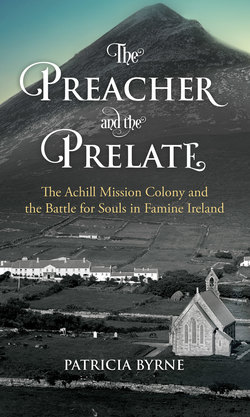Читать книгу The Preacher and the Prelate - Patricia Byrne - Страница 17
На сайте Литреса книга снята с продажи.
ОглавлениеCHAPTER SIX
Is it a Wafer or is it a God?
The partisan battle in Achill moved beyond the island and erupted in a tumultuous public event where the Christian doctrine of the Eucharist became a lightning rod for the animosity between Edward Nangle and his followers on the one hand, and the priests on the other. Newport’s rector and priest, whose relations were widely known to be acrimonious, faced one another at a gathering that rippled with hostility and division. The tension between the pair had been building for months, even years, and finally James Hughes and William Stoney confronted one another in the imposing surroundings of Castlebar Courthouse in bitter January conditions. The recent weather appeared to match the temper of the protagonists as hurricanes and snowstorms swept through the west, leaving the lakes around Castlebar frozen over and some mail cars unable to pass, such was the depth of snow. Edward Nangle was in the midst of the commotion, acting as chairman for William Stoney in the dispute about weighty theological issues.1
The public debate would centre on the Christian rite of the Eucharist, through which Christians remember Christ’s sacrifice on the cross, but which was a rite with very different teachings in Catholicism and the reformed church. For Catholics, the bread and wine of the Eucharist were transformed through the process of transubstantiation into the body and blood of Christ, while the reformed church believed in a spiritual presence of Christ during the rite. The Eucharist became the topic around which the two rival religious groups expressed their mutual hostility.
William Stoney’s association with the Achill Mission infuriated James Hughes, and he had written a lengthy letter to the Lord Lieutenant complaining that the Achill project blended everything that was ‘cruel, unjust, lying and hypocritical’. He and William Stoney were neighbours: ‘We live in the same town, not more than a quarter of a mile asunder.’ It was Stoney, he claimed, who purchased the land for the Achill Mission colony and who conspired with Edward Nangle to induce the islanders to abandon their faith with bribes of money, cattle, houses and land.2
In a series of acrimonious exchanges, the pair of clergymen squabbled endlessly about the debate arrangements before finally challenging each other’s debating prowess in Castlebar at an event that captured the public’s interest. The rules of debate were agreed with their respective chairmen, Edward Nangle and Father Loftus of Dunmore: there would be ten points for discussion, with three hours allocated for the consideration of each point; neither debater would interrupt the other while speaking; and the chairman alone could call the speakers to order. They agreed that 300 people from each side would be admitted by ticket, but it would prove impossible to control the crowds that swelled into the courthouse despite the inclement weather. At 10am on Friday, 6 January 1837, the event got underway in Castlebar in an atmosphere of hysteria and hostility. It was an astonishing affair, akin to a prize fight between two champion boxers, each cheered to the rafters by his full-blooded supporters.
Edward Nangle had already been accused of circulating pamphlets in Achill with an image considered to be deeply wounding to Catholics: the picture of a mouse holding a Eucharistic wafer in its mouth while being pursued by a priest. It was seen in the community as a blasphemous illustration which ridiculed the most sacred aspect of Roman Catholicism and caused deep offence. To this day, an Irish Catholic generation views the Eucharistic, Holy Communion, as the most sacred element of their religion.
At one time, receiving the host required one to fast from food and drink, the unleavened bread could not be touched by hand nor bitten by teeth and it was a cause of consternation if the host fell to the ground as only the priest could handle the consecrated bread (bread transformed into the body and blood of Jesus Christ while still retaining the appearance of unleavened bread – the central Roman Catholic doctrine of transubstantiation).
The image which caused such uproar in Achill is in the crackled yellow pages of the Protestant Penny Magazine illustrating an Edward Nangle piece of writing entitled ‘Transubstantiation disproved by a mouse’. The wood-cut illustration shows a Eucharistic wafer under the paws of a mouse while a priest and servant pursue the small animal. Edward Nangle wrote that the Catholic Council of Trent, no less, had decreed that if a consecrated host was taken accidentally by a mouse, or any such animal, ‘let that animal, if he can be taken, killed and burnt, and his ashes cast into consecrated ground’. For Edward, the image represented the fanciful Council of Trent doctrine that the whole Christ is contained in every particle of the Eucharistic wafer: ‘a senseless wafer-Christ in the place of a living God!’ In circulating the image in his pamphlets, he claimed to be doing nothing more than presenting Roman Catholics’ own idolatrous belief in a visual manner.
